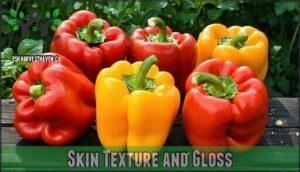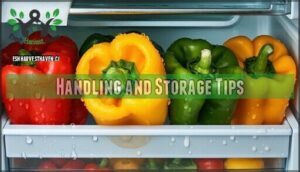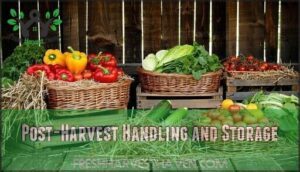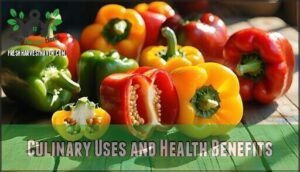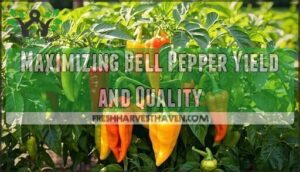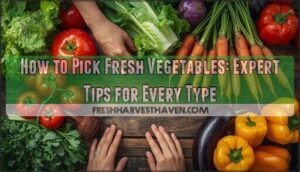This site is supported by our readers. We may earn a commission, at no cost to you, if you purchase through links.
 You’ll know when to harvest bell peppers by checking for size and firmness.
You’ll know when to harvest bell peppers by checking for size and firmness.
Green peppers are ready when they’re 3-4 inches long with glossy, thick skin – usually 60-90 days after planting.
If you want colored peppers, wait another 2-3 weeks for reds, yellows, or oranges to develop.
Think of it like waiting for fruit to ripen – patience pays off with sweeter flavor.
Press gently; ripe peppers feel firm but give slightly.
Harvest regularly to keep plants producing.
Don’t let them get soft or wrinkled, or you’ve missed the sweet spot.
The right timing reveals secrets that transform your garden’s potential.
Table Of Contents
- Key Takeaways
- Bell Pepper Growth Timeline
- When to Harvest Bell Peppers
- Signs of Bell Pepper Ripeness
- Harvesting Bell Pepper Techniques
- Post-Harvest Handling and Storage
- Culinary Uses and Health Benefits
- Maximizing Bell Pepper Yield and Quality
- Frequently Asked Questions (FAQs)
- How do you harvest a bell pepper?
- How to identify when bell peppers are ready for harvest?
- When should you harvest bell peppers?
- How do you pick a bell pepper?
- Can you harvest bell peppers too early?
- Do bell peppers regrow after being harvested?
- How many bell peppers per plant typically?
- What causes bell peppers to crack or split?
- Should you pick bell peppers before rain?
- Conclusion
Key Takeaways
- You’ll know they’re ready when they’re 3-4 inches long with glossy, thick skin – green peppers are ready at 60-90 days after planting, but wait another 2-3 weeks if you want colored varieties for a sweeter flavor.
- Check for firmness by pressing gently – ripe peppers feel firm but give slightly when pressed, and you shouldn’t wait until they become soft or wrinkled, since you’ll miss the optimal harvest window.
- Harvest regularly to keep your plants producing – use sharp pruning shears to cut the stem about one inch above the pepper, and pick peppers daily during the ripening season to encourage continued fruit production.
- Time your harvest for maximum freshness – pick peppers in the morning when it’s cool and dry, then store whole peppers in your refrigerator’s crisper drawer, where they’ll stay fresh for up to two weeks.
Bell Pepper Growth Timeline
Understanding your bell pepper’s growth timeline helps you plan the perfect harvest and get the best flavor from your garden.
You’ll need to track three key stages: the 60-90 days from transplant to harvest, the 14-20 days for fruit development after flowering, and the final 2-4 weeks for color changes from green to red, yellow, or orange, which includes the process of fruit development.
Days to Harvest
Your bell pepper harvest timeframe depends on your growing method.
Timing is everything—know your growing method to nail the perfect pepper harvest window.
Transplanted peppers reach maturity in 60-90 days, while seed-started varieties need 90-150 days.
Most bell pepper varieties hit their prime timing around 70-85 days from seed.
This ripening duration varies by variety influence—some cultivars mature faster than others.
Check your seed packet for specific days to harvest guidelines to ensure you’re picking your peppers at the right time for optimal flavor and texture, considering the prime timing.
Seed to Fruit Growth
Growing bell peppers from seed to harvest involves several pepper growth stages that you’ll want to track.
Germination factors like temperature and moisture kickstart seedling development, while environmental impact and varietal differences affect timing.
Here’s what influences seed development:
- Temperature consistency – Seeds need 70-80°F for proper germination
- Moisture levels – Steady watering promotes healthy pepper development
- Light exposure – Adequate sunlight drives growth stages forward
Flowering to Ripening
After pollination impact occurs, your pepper development enters its most exciting phase.
Flower development leads to fruit set within days, marking the start of a 50-60 day ripening journey.
Bell pepper maturity follows predictable color progression from green to red, yellow, or orange.
For ideal flavor and longevity, consider selecting firm peppers at their peak ripeness.
Ripening factors like temperature and sunlight determine your days to harvest, with pepper growth stages becoming clearly visible as fruits reach full size, influenced by temperature and sunlight and leading to full size.
When to Harvest Bell Peppers
Timing your bell pepper harvest isn’t rocket science, but it does require attention to detail. You’ll want to harvest these colorful gems when they reach prime ripeness for maximum flavor development.
Generally, you can start picking peppers 60-90 days after transplanting, though variety differences play a vital role in timing. The harvesting impact on your plant’s productivity can’t be overstated—regular picking encourages more fruit production.
Environmental factors like temperature and sunlight also influence when to pick peppers. You don’t have to wait for full color change; green peppers are perfectly edible, just less sweet. For longer preservation, consider various storage methods like freezing or pickling.
Your pepper harvesting guide should include checking plants daily as they approach maturity. Ripe bell peppers will show their true colors and feel firm to the touch. Remember, bell pepper ripeness varies by variety, so know what you’re growing when harvesting bell peppers. This is crucial for maximum flavor development and to ensure you’re picking the peppers at the right time for your specific variety.
Signs of Bell Pepper Ripeness
You’ll know your bell peppers are ready when they show specific changes in color, size, and texture that signal peak ripeness.
These clear signs help you pick peppers at the right time for the best flavor and longest storage life.
Color Indicators
Color serves as your most reliable guide for bell pepper ripeness.
Green peppers represent the earliest harvest stage, while red, yellow, and orange show full maturity.
This color transformation directly impacts sweetness—red peppers contain higher sugar content than green ones.
The vibrant hues are due to carotenoid concentration levels that increase as they ripen.
Watch for uniform, glossy color change from top to bottom as visual cues indicate ideal ripening stages for maximum flavor impact, which is influenced by the color transformation.
Size and Shape
Beyond color changes, bell pepper size and shape tell you when they’re ready. Look for ideal dimensions of 3-4 inches long and wide with that classic blocky shape.
Your peppers should feel substantial – proper pepper weight means they’re mature. Check for uniform growth across the fruit.
Remember, varietal differences affect final size, so know your specific variety’s expected dimensions when harvesting bell peppers.
Harvesting should ideally occur in the morning, taking advantage of crispiest pepper conditions at crispiest pepper conditions.
Skin Texture and Gloss
A pepper’s skin tells its story through texture and shine.
Ripe bell peppers develop a glossy appearance that catches light beautifully, while immature ones look dull and matte.
When harvesting bell peppers, check for firm skin without wrinkling signs or skin imperfections.
Soft spots indicate overripeness.
The texture changes from rough to smooth as peppers mature, signaling perfect harvest timing.
Harvesting Bell Pepper Techniques
Once you know your bell peppers are ready, you’ll need the right tools and methods to harvest them without damaging the plant.
Using sharp pruning shears or scissors, cut the stem about one inch above the pepper to keep both the fruit and plant healthy for continued production.
Cutting Tools and Methods
Sharp pruning shears make all the difference when harvesting bell peppers.
You’ll want to cut the stem about half an inch above the fruit while supporting the pepper with your nondominant hand. Your dominant hand controls the cutting tool for precision.
For superior performance, consider purchasing high-quality cutting tools.
Essential harvesting techniques include:
- Shear sharpness – Clean cuts prevent plant damage
- Tool sanitation – Alcohol wipes stop disease spread
- Stem length – Leave enough for freshness
- Glove usage – Protect hands during harvest
Harvesting at Optimal Time
Morning harvests deliver peak flavor when dew evaporates but temperatures stay cool.
Catch the morning magic—harvest your peppers when the dew lifts but the heat hasn’t hit.
You’ll maximize yield optimization by checking plants daily during ripening stages, catching peppers at perfect maturity.
Don’t wait for every pepper to reach full color—preventative harvesting of mature green ones encourages extended harvest from remaining fruits.
This pepper harvesting strategy keeps your plants producing longer while ensuring ideal harvesting time for each pepper’s development stage, allowing for preventative harvesting and promoting extended harvest.
Handling and Storage Tips
After cutting your peppers, proper storage keeps them fresh longer.
Store whole peppers in your refrigerator’s crisper drawer with a paper towel to prevent moisture buildup. Consider replacing damaged crisper drawers to maintain ideal humidity.
They’ll stay crisp for up to two weeks. For freezing methods, blanch peppers first, then freeze in airtight bags.
Green peppers continue ripening after harvest when stored at room temperature.
Post-Harvest Handling and Storage
Once you’ve harvested your bell peppers, proper handling and storage will keep them fresh and flavorful for weeks.
You’ll need to know the right techniques for refrigeration, freezing, and preservation to make the most of your pepper harvest.
Refrigeration and Shelf Life
Proper refrigerator storage keeps your freshly harvested peppers crisp for weeks. Store whole, unwashed peppers in the crisper drawer where ideal humidity prevents moisture buildup and extends refrigeration duration. Your peppers will stay fresh longer when you maintain consistent refrigerator conditions.
- Temperature control: Keep your fridge between 38-40°F for maximum freshness
- Moisture prevention: Place dry paper towels in storage containers to absorb excess humidity
- Airflow matters: Don’t overcrowd the crisper drawer – peppers need breathing room
- Timing counts: Check stored peppers every few days for signs of softening or decay
- Whole is better: Store peppers intact rather than cut to maximize shelf life
Freezing and Dehydration
Freezing methods preserve your bell pepper harvest without blanching – just wash, dry, and remove seeds before freezing whole or chopped.
Dehydrator drying concentrates flavors while maintaining nutrient retention for months.
Both preservation techniques change texture slightly but extend storage duration substantially.
Consider products for freezing to simplify the process.
Your frozen peppers work great in cooked dishes, while dehydrated ones make excellent pepper flakes.
Pickling and Preservation
Pickling transforms your harvested peppers into tangy treasures that last months.
Create simple pickling brines with vinegar, water, sugar, and salt for crisp results.
Try fermented peppers for probiotics, or make pepper jams for sweet heat.
Traditional drying methods preserve peppers naturally, while oil infusions capture their essence.
These preservation techniques extend your harvest’s life substantially.
Culinary Uses and Health Benefits
You’ll discover that perfectly timed bell pepper harvests offer maximum nutritional benefits, with red peppers containing more vitamin A and vitamin C than their green counterparts.
Your cooking options expand dramatically when you understand how harvest timing affects flavor, from crisp green peppers perfect for stir-fries to sweet red peppers ideal for roasting and salads.
Nutritional Value and Versatility
Beyond their vibrant bell pepper color, these nutritious gems pack serious health benefits.
With only 31 calories per 100 grams, bell peppers deliver impressive vitamin content—red varieties contain 158% daily vitamin C needs.
Their cooking versatility shines in stir-fries, salads, and stuffed preparations, while raw consumption maximizes nutrients.
Smart pepper pairings enhance both flavor and pepper nutritional benefits during harvesting season.
Many cooks also use versatile culinary favorites to enhance the flavor of bell pepper dishes.
Recipes and Cooking Methods
Five cooking techniques reveal your bell pepper’s full potential.
Pepper roasting brings out sweet, smoky flavors perfect for sauces. Stuffing peppers creates hearty meals using rice or meat fillings.
Raw pepper salads add crunch and vibrant color to dishes. Quick stir-fries preserve their crisp texture while blending flavors.
Try making pepper chips for healthy snacks that showcase their natural sweetness, using techniques like quick stir-fries and pepper roasting to bring out the best in your bell peppers.
Exploring Different Pepper Varieties
Why limit yourself to standard bell pepper varieties when dozens of exciting options await your garden?
From sweet banana peppers to fiery habaneros, each variety brings unique flavors and harvest timing. Understanding different pepper types helps you plan diverse harvests throughout the growing season.
- Hot Pepper Varieties – Jalapeños, serranos, and cayennes offer varying Scoville Scale heat levels
- Sweet Pepper Types – Hungarian wax, Italian sweet, and cubanelle provide mild, flavorful alternatives
- Heirloom Pepper Flavors – Purple beauty and chocolate bell peppers deliver unique colors and tastes
Maximizing Bell Pepper Yield and Quality
You can boost your bell pepper harvest by checking your plants daily and picking peppers at the right time.
Regular harvesting encourages your plants to keep producing more fruit, while proper timing guarantees you get the best flavor and longest storage life, which can be achieved by regular harvesting.
Regular Inspection and Harvesting
Check your bell pepper plants every day during pepper harvest season.
You’ll spot ripe peppers faster and boost your yield.
Look for the right bell pepper color and size changes.
This harvest frequency keeps plants producing more peppers.
Regular harvesting tips include morning checks when it’s dry.
Your bell pepper growing success depends on ideal timing and quality control for maximum plant health.
Supporting Plant Growth and Health
Healthy pepper plants produce bigger harvests.
Check soil health regularly and maintain proper nutrient balance through balanced fertilizing. Water consistently but don’t overwater—soggy roots kill plants.
Provide six hours of direct sunlight daily for ideal pepper growth. Watch for pests and diseases, treating problems quickly.
Good pepper plant care means removing damaged leaves and supporting heavy branches with stakes to ensure proper nutrient balance.
Extending Shelf Life and Storage
Proper pepper storage starts with ideal refrigeration in your crisper drawer.
Store peppers in mesh bag storage or plastic bag storage with paper towels for moisture control.
Freezing methods work after blanching, while dehydration techniques preserve peppers for months.
Try pickling peppers in vinegar solution, and remember that ripening after-harvest continues slowly, so these storage methods maximize your harvest’s lifespan.
Frequently Asked Questions (FAQs)
How do you harvest a bell pepper?
Like performing surgery on a delicate patient, you’ll need sharp pruning shears to cleanly cut the stem about one inch above the pepper.
Support the fruit gently while cutting to avoid damaging the plant.
How to identify when bell peppers are ready for harvest?
Look for peppers that are 3-4 inches wide, firm to touch, and glossy.
They’ll feel heavy for their size.
Green peppers are ready now, but you can wait for red, yellow, or orange colors to develop.
When should you harvest bell peppers?
You’ll know it’s time when your bell peppers reach 3-4 inches in size, feel firm with slight give, and show their mature color—whether that’s green, red, yellow, or orange depending on your variety.
How do you pick a bell pepper?
Use sharp pruning shears or clean scissors to cut the pepper’s stem about one inch above the fruit.
Support the pepper while cutting to avoid damaging the plant or breaking branches.
Can you harvest bell peppers too early?
Yes, you can harvest bell peppers too early.
If you pick them before they’re fully developed, they’ll lack flavor, sweetness, and proper texture.
Wait until they’re firm, glossy, and reach their intended color for best results.
Do bell peppers regrow after being harvested?
Notably, bell pepper plants don’t regrow the same fruit after you’ve harvested it. However, they’ll keep producing new peppers throughout the growing season, giving you multiple harvests from one plant.
How many bell peppers per plant typically?
You’ll typically get 6-12 bell peppers per plant during the growing season.
Factors like variety, growing conditions, care, and weather affect your harvest.
Healthy plants in ideal conditions often produce on the higher end of this range.
What causes bell peppers to crack or split?
Like overstretched balloons, bell peppers crack when they absorb water too quickly after dry periods.
You’ll prevent splitting by maintaining consistent soil moisture, avoiding overwatering after drought, and harvesting before fruits become overly mature to ensure the best results.
Should you pick bell peppers before rain?
You should pick bell peppers before heavy rain to prevent cracking and splitting.
Harvest them when they’re dry, ideally in the morning after dew evaporates, to maximize shelf life and quality.
Conclusion
Mastering when to harvest bell peppers is like learning to read nature’s calendar—timing makes all the difference.
You’ll enjoy sweeter flavors and better yields when you harvest at the right moment.
Green peppers offer crisp texture, while colored varieties provide enhanced sweetness.
Regular harvesting keeps your plants productive throughout the growing season.
With proper timing and technique, you’ll maximize both quality and quantity from your pepper garden, ensuring fresh peppers for your kitchen year-round.



